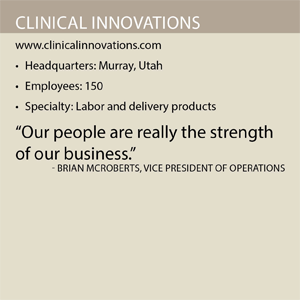Clinical Innovations
Clinical Innovations’ manufacturing and assembly process typically runs so smoothly that it can be easy for management to take for granted.
“When you look at the manufacturing schedule here, it’s almost like setting a clock – it’s repetitious and predictable,” Vice President of Operations Brian McRoberts says. “We have a very stable operation and have very few issues manufacturing-speaking, and that boils down to our people.”
The company has a highly dedicated staff and enjoys a low turnover rate. “Many of our people have been here for many, many years,” he adds. “They are really the strength of our business.”
Clinical Innovations’ staff plays a critical role in ensuring the quality of its products. “We leverage the stability in our manufacturing,” McRoberts says. “Our customers have a high view of our quality and that is because of our dedicated workforce.”
Founded in 1993, the company is today owned by the Chicago-based Pritzker Group, which owns and operates market-leading manufactured products, services and healthcare companies.
A Specialized Focus
Manufacturing quality is vitally important to Clinical Innovations because of the nature of its products. The company is the largest manufacturer of medical devices related to women’s labor and child delivery in the world.
“We’re really the only company that specializes in what we do,” McRoberts says. “There are other companies that play in this space, but for them it’s a small part of a multi-faceted business.
For others, these products are just something additional in the sales rep’s bag and don’t get a lot of focus – our products get a lot of focus from our salespeople.”
This focus on women and infant health gives the company a specific market that is dictated by birth rates around the world. Although the birth rate have gone down worldwide over the past several years, Clinical Innovations has grown its business by introducing new products. One of the company’s newest products, the ROM Plus test for in-vitro membrane ruptures, places it in the diagnostic market, where it wasn’t previously, McRoberts notes.
Evolving Capabilities
The company’s wide product variety has led it in recent years to contract some of its manufacturing out to third parties. “As we bring new products into the business, we find that a lot of those don’t align with our core capabilities,” McRoberts says, noting the company has expanded its contract manufacturing from one to five sites within the past few years.
 One example is the traxi panniculus retractor, which is used to position morbidly obese women during caesarean section procedures. Clinical Innovation uses an outside manufacturer to produce the product to its specifications.
One example is the traxi panniculus retractor, which is used to position morbidly obese women during caesarean section procedures. Clinical Innovation uses an outside manufacturer to produce the product to its specifications.
The company also contracts with companies that have converting and wet chemistry capabilities.
Much of the manufacturing performed in the company’s 30,000-square-foot manufacturing facility in Murray, Utah, is related to product assembly. The facility is ISO 13485 certified for medical device manufacturing. “You’ll find 90-plus percent of our people in the clean room handling assembly,” he adds.
The company also has injection molding and tooling capabilities. “We build new tools each year to support new product introductions or new research projects,” McRoberts says.
Clinical Innovations’ manufacturing volume varies by product, with its highest volume products selling roughly 1 million units a year, and its lower-volume products ranging in the few thousands of units produced annually. The company meets regularly with sales, marketing, operations and finance teams to plan its production. “Our approach to inventory continues to evolve,” he adds.
In addition to improving its inventory management practices, the company also is enhancing its overall quality and productivity. “As a medical manufacturer, we have to have a robust quality management system,” McRoberts says.
The company recently hired a Six Sigma black belt with the intention of implementing lean manufacturing practices throughout its operations. “Lean is a new concept here, but it is something I’ve been familiar with and had exposure to previously,” he adds.
Meeting Needs
Community and industry involvement is important to Clinical Innovations. Employees regularly volunteer their time for causes including the Feed My Starving Children child nutrition program.
The company also is involved in industry training programs, including the University of Utah’s “Bench to Bedside” competition. The program introduces medical, engineering and business students to the world of medical device innovation by splitting them into teams tasked with identifying unmet clinical needs. Teams are given access to physicians to serve as consultants.
Clinical Innovations also is involved in a clinical study led by the World Health Organization that is examining ways to control the AIDS epidemic in Africa. The company is producing and providing its AccuCirc device, a single-use male circumcision kit that can be used in any setting, to WHO. The removal of male foreskin is believed to make it more difficult for the AIDS virus to enter the body, the company and published literature says.
“We believe this product has a lot of potential, not just from a sales standpoint, but as a way of serving a major health need,” McRoberts says.